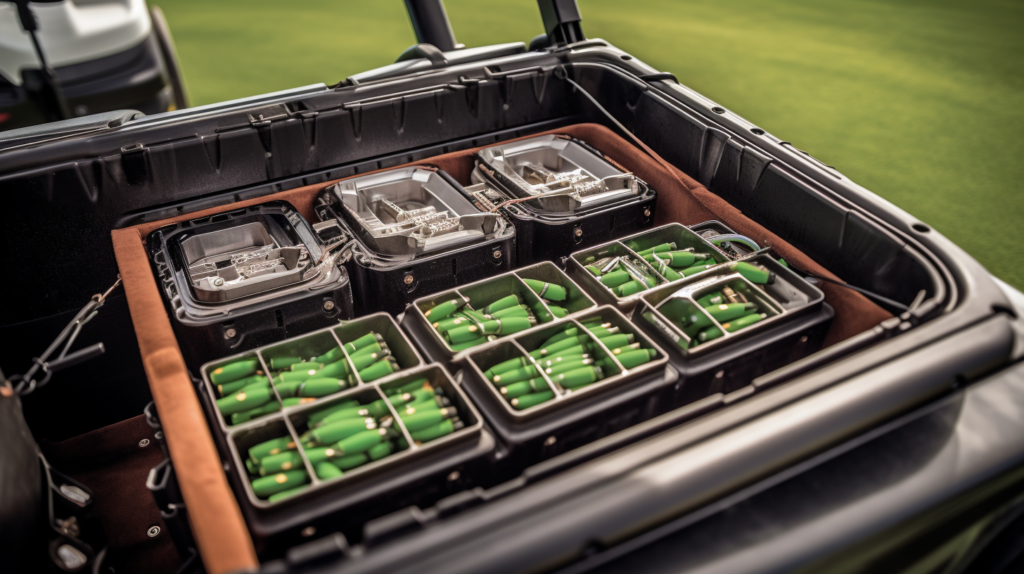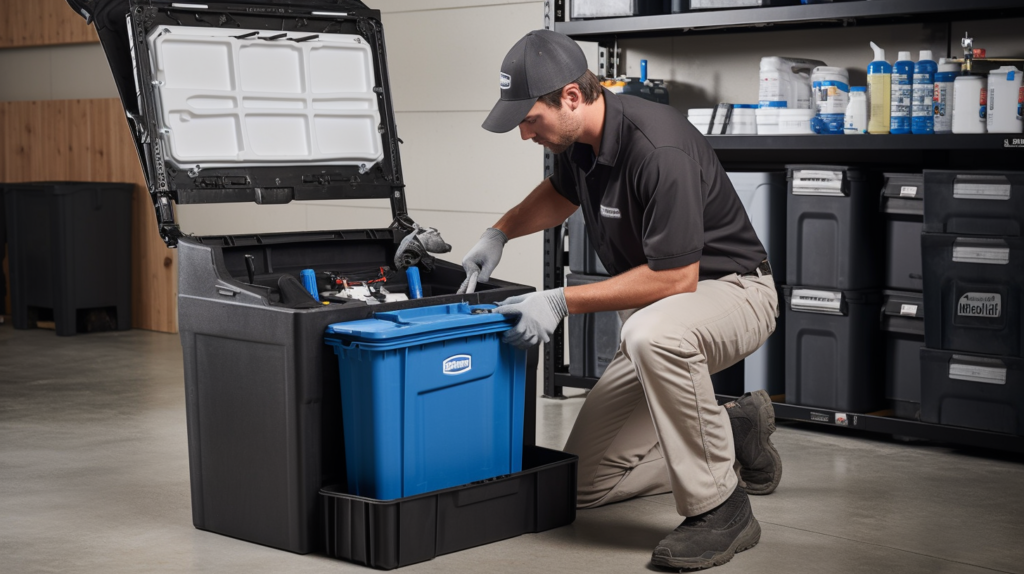Do you find yourself constantly wondering if your golf cart’s batteries are about to die, leaving you stranded out on the course?
The lifespan of golf cart batteries varies substantially based on several key factors.
Let’s dive into everything you need to know about how long golf cart batteries really last.
Here is a new section answering the main question “How long do golf cart batteries last?”:
How Long Do Golf Cart Batteries Last?

Most golf cart batteries last 3-5 years before needing replacement. Most quality deep-cycle golf cart batteries typically last between 300 and 400 full discharge and recharge cycles when well maintained.
However, many factors affect overall battery longevity, including usage frequency, recharge practices, storage conditions, and battery type.
Following best practices around full recharging, proper temperature storage, routine maintenance, and avoiding damage can help maximize the years of service life for your golf cart’s batteries.
What Type of Batteries Do Golf Carts Use?

Golf carts typically use lead-acid batteries, which are a type of rechargeable deep-cycle battery designed to handle repeated discharges and recharges.
Within lead-acid batteries, there are two main types used in most golf cart applications: flooded lead-acid batteries and absorbed glass mat (AGM) batteries.
Flooded batteries have liquid electrolyte that requires maintenance, while AGM batteries eliminate the need to refill since the electrolyte is contained in a fiberglass mat.
Both battery types come in different sizes and voltages to meet the specific electrical demands of various golf cart models. Common sizes include six-volt, eight-volt, and twelve-volt batteries wired together in series and parallel to produce the required voltage and capacity.
How Many Charging Cycles Do They Typically Last?

When properly maintained, a quality deep-cycle golf cart battery will generally last around three hundred to four hundred full discharge and recharge cycles before needing replacement. However, the actual lifespan in cycles can vary quite a bit depending on several factors.
Shallow discharging of a battery followed by recharges will yield more cycles versus repetitive deep discharging, which puts more strain on the internal components.
Overcharging or undercharging on a frequent basis also shortens overall battery life by accelerating wear or enabling sulfation buildup. Extreme hot or cold temperatures while charging, discharging, or storing batteries impacts cycle life as well.
With optimal conditions and care, some AGM batteries may achieve five hundred to eight hundred cycles.
But for most applications under average usage patterns, golfers can expect roughly four hundred cycles from their cart batteries before noticing a considerable reduction in range or capacity that indicates aging batteries due to old age.
What Factors Impact Golf Cart Battery Life?

Golf cart battery lifespan is affected by a variety of factors that dictate how many charging cycles or years of service life the batteries can realistically provide.
By understanding the key elements that impact the effective usable life of golf cart batteries, owners can better employ best practices to maximize battery durability and performance over time.
The major factors influencing battery lifespan fall into general categories related to usage, environmental conditions, and battery age and underlying construction.
Usage and Maintenance
How a golf cart battery is used and maintained plays a significant role in determining its effective lifespan. The depth and frequency of discharges impact the number of cycles the battery can handle before failure.
Deep discharging places greater strain on the battery components compared to more shallow discharges. However, routinely recharging a battery before it becomes completely depleted helps preserve its overall life and functionality.
Neglecting to fully recharge on a regular basis also shortens life expectancy by enabling sulfation buildup on the lead plates inside the battery. Overcharging or charging at excessively high voltages can overheat batteries and accelerate wear as well.
Proper ongoing battery maintenance is also essential, including regular inspection of water/electrolyte levels in flooded batteries and cleaning battery terminals when needed. Good maintenance ensures batteries operate efficiently for maximum cycles.
Environmental Conditions
The conditions that batteries are subjected to or stored in affects longevity as well. Extreme hot or cold ambient temperatures during operation, charging, or storage can influence internal chemical reactions and reduce capacity.
For example, battery capacity drops by around fifty percent when temperatures dip below freezing. Running batteries in wet conditions can cause corrosion over time on terminals and exposed metal components.
Excessive vibrations may also impact flooded batteries by causing electrolyte leakage. Care should be taken to keep batteries away from potential sources of damage from the elements to the extent possible.
Garage or enclosed storage helps shield batteries from extreme weather shifts compared to outdoor exposure. However, even garage-kept batteries experience gradual capacity loss with age as the components naturally wear out over years of use.
Battery Age and Chemistry
The age and underlying chemistry of golf cart batteries also play a role in functional life expectancy. Older batteries that have endured hundreds of cycles generally have less capacity left than newer batteries which have seen less usage.
And modern battery materials and compositions, such as absorbed glass mat (AGM) batteries, offer improved lifespan over more traditional flooded lead-acid batteries. The sealed AGM design better resists leakage, corrosion, and vibration damage.
And AGM batteries utilize modified separators and electrolytes that maximize cycle life compared to standard flooded batteries.
So an older flooded battery may only last a couple of years, while a new AGM battery could potentially get four to six years of useful life if properly maintained.
In general, most golf cart owners find they need to replace their batteries every three to five years to maintain adequate range and performance as batteries slowly lose usable capacity over time and hundreds of recharge cycles.
Best Practices to Maximize Lifespan

Following a few simple best practices around usage, charging, and maintenance helps golf cart owners maximize their battery lifespan and get the most value from their battery investment.
Fully Recharge After Each Use
One of the most effective things cart owners can do to extend battery life is to fully recharge batteries after each round of use. Allowing batteries to remain partially depleted for extended periods enables harmful sulfation buildup on the lead plates inside the battery.
This diminishes capacity and shortens the functional life of the battery. Therefore, it is advisable to not let more than forty-eight hours elapse before completing a full recharge cycle after normal usage.
Maintain Proper Storage Temperature
Keep batteries stored at moderate room temperatures whenever possible. Temperatures below freezing or above around one hundred degrees Fahrenheit place strain on batteries and accelerate aging effects.
Garage storage helps buffer temperature swings compared to keeping a cart outside year-round through extreme weather shifts. However, even in the garage, additional insulation or protection may be warranted during the hottest summer and coldest winter spells.
Regular Inspection and Maintenance
Routinely check battery water/electrolyte levels in flooded batteries and refill with distilled water as needed to prevent plate exposure. Clean battery terminals as required to eliminate heavy corrosion buildup that impedes electrical connectivity.
Battery maintenance often gets overlooked but goes a long way towards keeping batteries working efficiently.
Consider Replacement Every Three to Five Years

As lead-acid batteries inevitably age with heavy use over three to five years, replacing them proactively helps avoid being stranded with disabled batteries that fail unexpectedly from old age and worn-out components.
Most golf cart owners find a three to five year replacement timeframe provides the best balance of usable battery life while avoiding aging battery issues.
How to Test When It’s Time to Replace
Since battery lifespans vary considerably based on usage patterns and operating conditions, golf cart owners often wonder how to test when aging batteries require replacement. There are a few simple checks owners can perform themselves to gauge remaining battery life.
Perform a Load Test
Using a battery load tester or multi-meter, owners can run batteries through a controlled deep discharge and measure actual capacity. Healthy batteries should demonstrate at least eighty percent of rated capacity. Significantly less may indicate nearing end of life.
Check Charge Levels Over Time
If batteries are consistently failing to hold a charge for reasonable time periods, even with regular recharging, their ability to store energy may be seriously degraded.
Take notes on charge duration expectations over the course of a few months to identify degrading performance.
Inspect Physical Condition
As batteries age internally, visible clues also manifest externally in many cases. Heavily corroded and eroded terminals may indicate issues, as can cracked battery cases resulting in electrolyte leakage.
Also watch for any individual battery cells failing within a group wired configuration.
Replacing questionable aged batteries proactively before they leave a cart fully disabled often proves more convenient than reacting after the batteries completely fail in the middle of a round.
While lifespans vary based on several variables, most golf cart owners plan for new batteries every four hundred cycles or every three to five years. Staying ahead of potential battery failure enables continuously reliable cart operation.
Conclusion
In the end, most golf cart batteries last between 300-400 full charging cycles when properly maintained. Their lifespan depends heavily on usage and care, as well as environmental factors and battery age.
Following best practices like full recharging, moderate temperature storage, regular maintenance, and periodic replacement every 3-5 years helps golfers get the maximum lifespan from their batteries.
Tracking performance over time and conducting load testing identifies when failing batteries require replacement.



